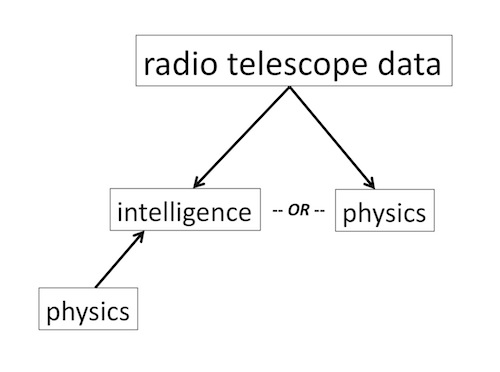 Evolution
Evolution
 Intelligent Design
Intelligent Design
Do You Like SETI? Fine, Then Let’s Dump Methodological Naturalism

After reading my article about methodological naturalism (MN), a correspondent wrote and asked a good question:
Doesn’t ID satisfy the requirements of MN, if we define MN as simply excluding inferences to supernatural causes? Obviously MN cannot rule out all cases of agent (versus strictly physical) causation. Because, if MN does exclude agent causation, then archaeology, the Search for Extraterrestrial Intelligence (SETI), and in fact many other areas of ongoing scientific research, would be placed outside the sphere of empirical knowledge — and that can’t be right.
ID seems committed only to detecting intelligence, not supernatural causes. If so, doesn’t ID fit easily within a modest formulation of MN? If we regard MN as a reasonable epistemological boundary, not a sweeping ontological claim about the non-existence of the supernatural, then it’s hard to see why ID theorists should worry about MN.
Here’s my reply to this reader. It turns out that SETI provides an illuminating test case for the validity of MN. Even a modest formulation of MN excludes too much, hindering us from learning what we really might want to find out.
Assessing the Damage MN Does to Freedom of Inquiry
Epistemology — how we know — and ontology — what exists — are both affected by methodological naturalism. If we say, "We cannot know that a mind caused x," laying down an epistemological boundary defined by MN, then our ontology comprising real causes for x won’t include minds.
MN entails an ontology in which minds are the consequence of physics, and thus, can only be placeholders for a more detailed causal account in which physics is the only (ultimate) actor. You didn’t write your email to me. Physics did, and informed you of that event after the fact.
"That’s crazy," you reply, "I certainly did write my email." Okay, then — to what does the pronoun "I" in that sentence refer?
Your personal agency; your mind. Are you supernatural? Who knows? Don’t get hung up on the "natural versus supernatural" distinction, which brings a world of mischief.
You are certainly an intelligent cause, however, and your intelligence does not collapse into physics. (If it does collapse — i.e., can be reduced without explanatory loss — we haven’t the faintest idea how, which amounts to the same thing.) To explain the effects you bring about in the world — such as your email, a real pattern — we must refer to you as a unique agent.
If ID satisfied MN as that philosophical doctrine is usually stated, the decades-long dispute over both wouldn’t have happened. The whole point of invoking MN (by the National Center for Science Education, for instance, or other anti-ID organizations) is to try to exclude ID, before a debate about the evidence can occur, by indicting ID for inferring non-physical causes.
That’s why pushing the MN emergency button is so useful to opponents of ID. Violate MN, if MN defines science, and the game is over.
If You Like SETI, You Should Dump MN
Or is it? Here’s where SETI provides an illuminating test case.
Most people — atheists, agnostics, theists, whatever — see the question "Does intelligent life exist elsewhere in the universe?" as an open puzzle to be investigated on the basis of the evidence. We can imagine all kinds of data that, if observed, would lead us to infer that an intelligence (at least one, anyway) had acted somewhere beyond the Earth; hence, the SETI research program.
At the heart of SETI — providing its very raison d’etre — is the following decision (logic) tree:

Figure 1
We can use "physics" as a shorthand for all undirected bottom-up causation (physics → chemistry → biology) where the most fundamental level of entities is mindless: "atoms and the void," to use the ancient expression. The undirected outcomes of physics represent what radio telescopes normally deliver to observers. As SETI Institute astronomer Jill Tarter explains in this interview,
that is "what Mother Nature does" — but that’s not what she or the SETI program want to find out. (The official SETI Institute rationale is here.)
Tarter is looking for what she calls "artifacts" — physical effects in the radio spectrum (such as a narrow-band pattern, where all the energy in the signal is concentrated within a few Hertz), warranting her to move down the other branch of the decision tree, to "intelligence."
Why? Because the effect in question cannot be produced by physics alone. At least one intelligence must be causally involved.
Now here’s the twist. Tarter herself is an atheist. In her view, the extraterrestrial intelligence she seeks to discover was, like her own, produced by a long evolutionary process, in which the fundamental causes were all natural (material and physical). So surely, as a philosophical naturalist, Tarter could endorse MN?
Nope — not without surrendering her SETI research goals at the same time. SETI requires the basic decision (logic) tree of "intelligence OR physics," which means isolating and seeking to detect some aspect of intelligence that is irreducible to physics. And that defies the "physics only, in the end" claim of MN.
To see why, consider this expanded decision tree:

Figure 2
While this schema reflects Tarter’s overall understanding of reality — intelligence anywhere in the universe was caused by undirected evolution — it does not allow her to eliminate the box labeled "intelligence." That is, her ontology must include "intelligence" (no matter how it arrived on the scene) as a cause that produces diagnostically unique effects.
Otherwise, she and the whole SETI program have nothing to detect. You can’t sift radio telescope data looking for something (i.e., a diagnostic effect, such as a narrow band pattern, uniquely implicating intelligence) that could not possibly be there.
Physics or physics (see Figure 3) is just not interesting if you want to discover intelligence.
Here is what happens to SETI research if we follow MN with complete consistency, and eliminate "intelligence," because we think that category is ultimately a temporary placeholder for a fully comprehensive physical account:

Figure 3
Tarter thinks the arrow from physics to intelligence in Figure 2 describes what actually happened in the evolution of the universe. Nonetheless, some feature of "intelligence" must be irreducible to physics, because otherwise we’re back to physics versus physics, and there’s nothing for SETI to look for.
Simple Ontology, Boring Universe
Having a nice, clean, simple ontology — atoms and the void — is easy to remember and even easier to distribute like handbills to passersby. No need to bother yourself with non-physical entities and messy concepts like "mind" or (atoms forbid) a transcendent intelligence, aka God.
But making the universe simple and easy to remember is hardly the same as letting your scientific curiosity go free, naked and unhindered into the complex forests of reality. That’s the path into the possibly scary unknown and the totally delightful regions of finding out something new.
